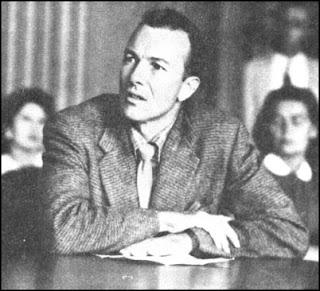1960-1963: Rebirth, out of prison. Life exciting, trying to make up for the years I'd been away. My Generation, the Beat Generation, had made it and I wasn't there…The fact that in prison I had done poetry and jazz with some of the best jazz musicians in the country didn't seem to carry any weight with me. Bea's seventy year old mother, Mary Morrison, was bringing me beat poetry from City Lights Bookstore in her native
1963-1966: The Art World. With friend Bill Dufty we founded monthly art magazine, ‘The
Both the Ford and Rockefeller Foundations turned down my proposal for help in completing a history of art exhibition - the follow-through of the already published volume - and said that they would underwrite it if I were to withdraw from the project. I became angry and destructive. I convinced myself that regardless of what I did or might accomplish, society would never forgive me for my role in McCarthyism. My bitterest act, greater than any I had ever known. I took all the research I had collected, and rented a fishing boat at
1965: My perception of a Christian society unable to forgive propelled me deeper into the counter culture of the 60's and 70's. Was deeply involved in the first "Underground" newspaper, ‘The East Village Other (EVO)’.Discovered Tim Leary and legal LSD, began taking trips and wandering into the unknown. In order to punish the United Fruit Company, helped create the hype that smoking banana peels would get you high.
'The outcome of the FDA study I have not been able to discover. However, in November 1967 researchers at New York University reported that a chemical analysis of banana peel had found no intoxicating chemicals and that the high was mainly psychological. It was obvious at the time, at least to some of us, that the whole thing was a put-on. I'll bet even the pranksters at the Barb didn't expect suckers to be falling for it 35 years later.'
Source: The Straight Dope
1965-1966: Bea and I separated… Norman Mailer and I to get to know one another. I had met him at Sy Krim's 40th Birthday party. Liked him, trusted his non-Christian soul. He had a directness and clarity which made me comfortable. When he ran for Mayor of
 Reconnected with Bobby Kennedy, who I hadn't seen since McCarthy Committee days. LSD still legal, and arranged for Kennedy to get acid for trip prior to his holding hearings on subject. He wanted to know what it was, etc. Connected thru Walter Bowart of EVO, also we gathered much information for the Committee regarding youth and drugs etc.
Reconnected with Bobby Kennedy, who I hadn't seen since McCarthy Committee days. LSD still legal, and arranged for Kennedy to get acid for trip prior to his holding hearings on subject. He wanted to know what it was, etc. Connected thru Walter Bowart of EVO, also we gathered much information for the Committee regarding youth and drugs etc.
‘We talked for several hours in his Central Park West apartment one morning in late 1966 or 1967. I was working on a study of LSD users and he was then proselytizing for acid with the same religious fervor he’d sold subscriptions to The Daily Worker in his Communist days, had been an anti-Communist in his informer days, and then an anti-anti-Communist in his post-informer days.
‘That afternoon, I described the encounter to Irwin Silber, editor of Sing Out! magazine. “Do I know him?” Irwin yelled, even though it was just two of us in the room “That sonofabitch turned me in!”
‘Later that day, I saw a musician friend, Hedy West, and I told her about the coincidence of my morning meeting with Matusow and Silber’s having been one of his victims. “Harvey Matusow turned my father in,” Hedy said."He testified that my father was organizing Communist Boy Scout troops in
- Bruce Jackson: ‘Harvey Matusow: Death of A Snitch’
The main part of the article is an interview with filmmaker Emile de Antonio whose ‘Point of Order’ is considered the best documentary on McCarthy.
.’
Also began working with Deputy Mayor Marcus of
1964-1966: Following my "normal" life pattern of when in doubt, when at the emotional bottom, laugh your way back to balance. During my witness days I always had an outlet in night clubs doing sleezy stand-up comedy. Now did it again four to five nights a week on
Reconnect with Andy Warhol, who I hadn't seen since pre-prison days when I was married to Ellen, and with him almost pulled off a hype on David Suskind. Suskind was doing a TV special on Beatnik artists. Using a Russian accent, from Andy's phone, I convinced Suskind that I was a Russian poet. Would have made the programme, but, one of the group who was in on the hype couldn't contain the secret [and] Suskind found out.
Started to make films. Worked with Yoko and her husband Tony Cox and film maker Peter Goldman and Emile d'Antonio. Worked with d'Antonio and
Lane and d'Antonio invited me to a party in Great Neck,
Sources: Italic quotes and chronological entries: from the ‘Stringless Yo-Yo’. Chronological entries edited to correct mistypings and, in some cases, to make it read more fluently.

PETE SEEGER FOOTNOTES:
While working as an informant, Matusow provided information against folksingers. Pete Seeger's band the Weavers [who] went from a hit record with ‘The Lion Sleeps Tonight’ to being blacklisted and finding no work. Seeger later went to prison over his testimonies in the HUAC related witch-hunts but also forgave Matusow for his youthful mistakes and noted that Harvey never did more than cost Seeger a few jobs. ("The Lion Sleeps Tonight" was known at the time as "Wimoweh." Pete Seeger did not go to jail, though he was convicted for Contempt of Congress and issued a jail sentence.) [Wikipedia]

No comments:
Post a Comment